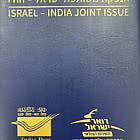In the 1840’s, Eretz Israel was a far-flung and meaningless part of the Ottoman Empire, with no organized transportation, trade or postal ties with the outside world. Foreign ships did not dock in Eretz Israel and the only way to get anywhere in the world was to travel by land via neighboring countries. Letters from overseas came into Beirut or Alexandria, and from there private messengers brought them to recipients.
Overland Mail
In the early 1920’s, it took 25 days to sail from Eretz Israel to Baghdad in Iraq. Brothers Norman and Gerald Nairn came to Eretz Israel as British soldiers during WWI and decided to stay after the war was over. Together they founded a new postal service that crossed the Syrian Desert in special vehicles, making it possible to travel between Haifa and Baghdad in just five days. The service began operating in 1923 and shuttled mail, passengers and cargo from Haifa to Baghdad via Beirut and Damascus until the end of the British Mandate in 1948.
The stamp dedicated to Overland Mail features an envelope sent from Baghdad to Haifa in the first delivery made by the new postal service, with a postcard of the Haifa train station in the background. The tab includes the special postmark that the sender was required to affix to the envelope to ensure that it would go via the quick overland service. A truck belonging to Haim Netanel, a Jewish merchant from Baghdad who was licensed to transport the overland mail in the late 1930’s, appears in the center of the stamp.
Sea Mail
The status of Eretz Israe changed as global shipping developed. In the mid-1850’s steamships belonging to Austrian and French shipping companies began to dock weekly in Jaffa, Haifa and Acre and in the late 1850’s they were joined by Russian ships as well. Thanks to this regular shipping schedule, foreign post offices were opened in Jaffa and in Haifa under the auspices of the Austrian, French and Russian consulates.
The stamp dedicated to Sea Mail features an envelope sent from the French post office in Jaffa bearing the Jaffa postmark, with a postcard of the Jaffa Port in the 19th century in the background. The tab includes a postmark from the Austrian post office in Jaffa, and the Russian mail ship Chihachov, which ran aground on the beach in Jaffa, appears in the center of the stamp.
Airmail
In the late 1920’s, international air travel began to develop between the European powers and their colonies around the world. The amounts of cargo that planes could transport and the distances they could fly were very limited at that time, so they had to land frequently during their flight routes. Thanks to its location between Europe and the Far East, Eretz Israel served as a convenient midway landing point for flights from Britain to India. In 1932, a new section of the flight to India began using a seaplane that took off from Limassol port in Cyprus and landed in the Sea of Galilee, near the shore in Tiberius. The plane’s contents were then transported to Zemach, at the southern end of the Sea of Galilee and from there they were transported by airplane to Baghdad.





















































